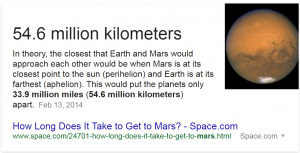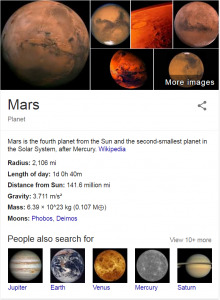This is part two in the micro-moments series. Last time we talked, we focused on “I want to go,” and how it closely connected to the local three pack. Towards the end of the post I mentioned how to apply it to other micro-moments as well. Today, we'll shift focus to the "I want to know" micro-moment.
The "I Want To Know" Micro-Moment
This is one of the most common micro-moments that we see in the search landscape. In fact, “I want to know” spurred the original search intent since the days of ten blue links and even before. This micro-moment represents users who are looking for information on a topic without a specific business related intention. These users search to find content that answers their question clearly and accurately. Once they have this information they can progress from "I want to know" and to the next micro-moment where they can use the answer they got to decide what to do next. "I want to know" is a very strong mobile micro-moment as well as a traditional type of desktop search. Use of mobile phones to find answers to questions or to pull up additional information to support a conversation has become commonplace. The board room, the park bench, and the dinner table make up locations that see heavy use of mobile search and the "know" micro-moment in particular.
SERP Features
Google seeks to provide users with clear answers to their questions. It might seem that this micro-moment is the catch-all for keywords which don’t belong to another micro-moment. However, Google's strategy indicates otherwise. A number of distinct SERP features indicate that Google believes a given keyword belongs to the “I want to know” micro-moment. If Google provides distinct and different SERP features, they see different user intentions on those keywords. Here are some of the SERP features that Google uses to provide information in response to "know" search queries.
Quick Answers
Quick Answers is a very popular SERP feature that does what it says on the tin - answers a question with a short blurb of content. You have probably seen it before even if you weren't aware of it a the time. Here's what it looks like:
This is probably the most intuitive feature of all for this micro-moment. Google answers the user's question directly. It doesn’t carry any additional context besides the answer to the question and an attribution link to the page which provided the content. This shows that Google understands that users searching this keyword are looking for a piece of information.
Knowledge Graph
Knowledge Graphs help Google provide critical information about a specific object. They have become more common lately as Google has built out their understanding of different object. Here's what a Knowledge graph card looks like as a quick example.  Knowledge Graphs are provided when the query identifies a specific object (usually a person or a place). This SERP feature differs as it doesn't always have such a clean mapping to the source website as this example does. The example pulls from Wikipedia, but Knowledge Graph cards focused on brands are often not sourced from the brand website directly and don't have a clear link to the site. Knowing this, Knowledge graph is a bit more difficult to deal with in the context of digital marketing. However, it does clearly serve the purpose of answering user questions and providing information aligned with the "know" micro-moment.
Knowledge Graphs are provided when the query identifies a specific object (usually a person or a place). This SERP feature differs as it doesn't always have such a clean mapping to the source website as this example does. The example pulls from Wikipedia, but Knowledge Graph cards focused on brands are often not sourced from the brand website directly and don't have a clear link to the site. Knowing this, Knowledge graph is a bit more difficult to deal with in the context of digital marketing. However, it does clearly serve the purpose of answering user questions and providing information aligned with the "know" micro-moment.
Conclusion
The "I want to know" micro-moment is a huge and very common micro-moment. Google does their best to identify these situations, and provide specific result types that will provide the best experience for their users. This helps simplify the marketer's job. Using the SERP features as a guide, it is possible to understand what micro-moments a keyword belongs to. Then you can create and execute a content strategy that allows you to build better content based on what users seek in any situation.
